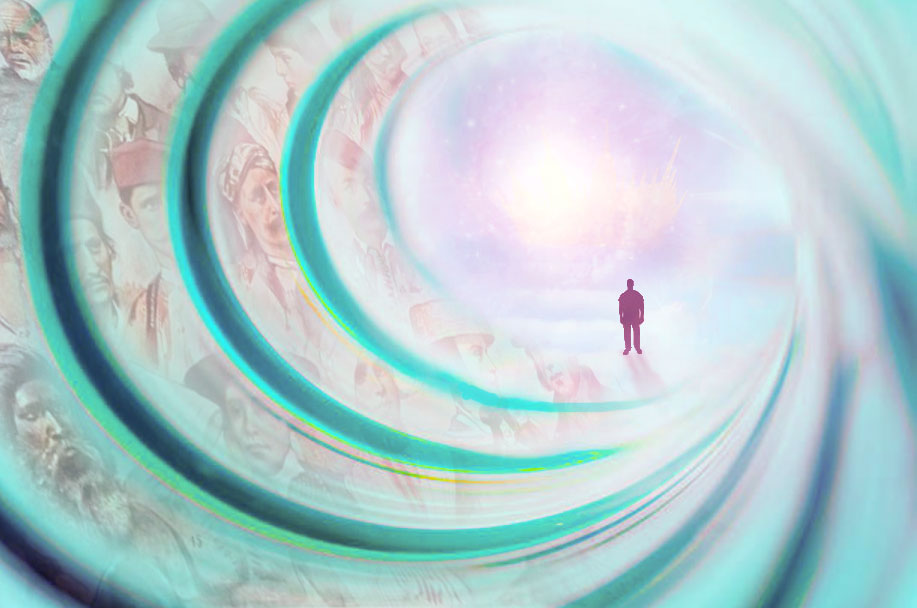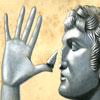Reincarnation: Mind To Body Karma
 by Gina Cerminara
by Gina Cerminara
If we can accept the idea of reincarnation, and the karmic psychology that accompanies it in the Cayce readings, we will see that there must follow, as the night the day, certain important conclusions. It is inevitable that the reincarnation idea will lead us to many changed points of view in our interpretation of life.
One of the major changes would be in our conception of the relation of mind to body. Although modern thinking tends to see body-mind as a hyphenated unit, as two interacting parts of the same whole, nonetheless the materialistic concept still prevails that the body is primary; that the mind cannot exist without the body; and that when the body dies, the mind dies too. In the reincarnationist’s view, all these concepts need to be reversed: the body is not primary, either in time or in causation; the mind has existed before this body came into being; and it will continue to exist after this body dies.
Moreover, if we speak only of body and mind, as it has been fashionable to do ever since the word ‘soul’ was outlawed from scientific respectability, we are speaking with inadequate terms. We will need another word, whether it be “soul,” “spirit,” “atman” (as the Hindus call it), “entity” (as Cayce called it), or “Thetan” (as the Scientologists call it) to designate the persisting part of us that seems to use both body and mind.
The very word, “reincarnation,” indicates by its origin the basic philosophic position that becomes necessary for its acceptance. It comes from the Latin re (again); in (in); and carne (the flesh); and it is related, interestingly enough, to the flower carnation, which our Caucasian forefathers so named because it was flesh-colored. The word-makers might just have reasonably coined the word “reincorporation” (back in the body, corpore) as back in the flesh, and if they had, the word might have been more interesting to the modern American mind.
In any case, reincarnation means that there is an immortal essence or soul which comes back to earth many times for the sake of experience, much as a student returns many hundreds of times to the same school building. For this purpose the eternal identity takes on a body of a density suitable for this realm of experience, and the body is then the protective covering or the garment of the soul. Hamlet ended his letter to Ophelia, “Thine evermore, most dear lady. Whilst this machine is to him, HAMLET”; and “machine” is as valid an analogy, in its way, as garment. It is suggestive of the Theosophical term for the body as the “vehicle” of the soul.
This concept is familiar to any person who has ever seen a Theosophical pamphlet on reincarnation, sat in on a Rosicrucian lecture on the subject, read the wisdom of the East or the philosophy of the Neo-Platonists, or stumbled on to certain poems of Walt Whitman.
Stanza 44 from Walt Whitman’s Song of Myself:
It is time to explain myself—let us stand up.
What is known I strip away,
I launch all men and women forward with me into the Unknown.
The clock indicates the moment—but what does eternity indicate?
We have thus far exhausted trillions of winters and summers,
There are trillions ahead, and trillions ahead of them.
Births have brought us richness and variety,
And other births will bring us richness and variety.
I do not call one greater and one smaller,
That which fills its period and place is equal to any.
Were mankind murderous or jealous upon you, my brother, my sister?
I am sorry for you, they are not murderous or jealous upon me,
All has been gentle with me, I keep no account with lamentation,
(What have I to do with lamentation?)
I am an acme of things accomplish’d, and I an encloser of things to be.
My feet strike an apex of the apices of the stairs,
On every step bunches of ages, and larger bunches between the steps,
All below duly travel’d, and still I mount and mount.
Rise after rise bow the phantoms behind me,
Afar down I see the huge first Nothing, I know I was even there,
I waited unseen and always, and slept through the lethargic mist,
And took my time, and took no hurt from the fetid carbon.
Long I was hugg’d close—long and long.
Immense have been the preparations for me,
Faithful and friendly the arms that have help’d me.
Cycles ferried my cradle, rowing and rowing like cheerful boatmen,
For room to me stars kept aside in their own rings,
They sent influences to look after what was to hold me.
Before I was born out of my mother generations guided me,
My embryo has never been torpid, nothing could overlay it.
For it the nebula cohered to an orb,
The long slow strata piled to rest it on,
Vast vegetables gave it sustenance,
Monstrous sauroids transported it in their mouths and deposited it with care.
All forces have been steadily employ’d to complete and delight me,
Now on this spot I stand with my robust soul.
But a close study of the Cayce material, and, in fact, of all clinical researches in past-life age-regressions, leads us to see that the human body, which we have so long taken for granted, is an area that requires drastic reconsideration.
There have been many ways, in humanity’s long history, of regarding the body. For the Greeks it was a thing of beauty, for the Romans, a thing of power and pleasure; for the Medieval Christians and the Puritans, a thing of shame and temptation, to be denied and despised, even beaten and abused.
According to the reincarnationist point of view, the body takes on a sudden and startling new significance. It may still be a thing of beauty and power; even, in wise moderation, a thing of pleasure; but it is no longer a thing of shame and evil. For to hate and abuse a body because it contains the possibilities of evil is no more intelligent than to hate and abuse an automobile because it contains the potentials of accident.
We begin to sense the awesome significance of human bodies when we come across some particularly conspicuous example of human deformity in the Cayce files, and learn that it is the mute but eloquent evidence of some past life crime against life.
Some of the most dramatic instances of this are found among that group of cases that we have chosen to classify as Boomerang Karma, adapting the term from the Australian weapon that can be thrown in such a way as to return to the point origin.
In Many Mansions we saw the case of a blind violinist who was told that he had once, as a member of an ancient Persian tribe, blinded his enemies with red-hot irons. Another blind man was told that, as an American Indian, he had tortured white captives in the eyes. Cruelty to others in the area of the eyes, then, led to the karmic consequence of experiencing in one’s own eyes the results of such cruelty—namely blindness.
An interesting variant appears in the case of a woman who developed iritis and later in life became totally blind in one eye. In a Persian incarnation she had, Cayce said, used her eyes hypnotically, to subject other people to her will and to her way of thinking. This was not cruelty, certainly, in the same way that physical torture in cruel; but it was selfishness and tyranny, and as such invoked karmic consequence in the area which was the physical instrumentality of her misuse of others; the eyes.
A woman of fifty-three who had had a serious back deformity since childhood, and who had lost part of one finger and had her hand mangled at the age of four, was told that she was an associate of the notorious emperor of Rome who persecuted early Christians. A young man of twenty-four became paralyzed from the neck down as a result of an automobile accident; he lived in this condition until the age of forty-two, entirely dependent upon charitable Christians for every detail of his care. He too had been a cruel persecutor of Christians.
In some cases, people are born with their physical affliction, and in some cases the affliction comes to them later in life. But in either case, it is clear that the kind of affliction that the body bears is meaningful, not haphazard.
Cayce indicated, it is true, that in some few cases a bodily affliction was not karmic in the strict sense of the term. A man who had lost one leg in an accident, for example, was told that this was not a karmic experience but one that afforded him an opportunity for fuller spiritual growth. Perhaps this is comparable to the case of the blind man about whom the disciples asked Christ. “Who sinned, this man or his parents, that he was born blind?” And Christ answered: “Neither, but that the works of God might be made manifest within him.”
So it seems that sometimes—but this very rarely—a body’s defects are not retributively significant of some episode in the soul’s past. However, they still remain meaningful in this sense: that the defect enables some weakness of the soul to become redeemed, or some new virtue to get its start. A piano coach sometimes makes his pupil play on a keyboard that has been covered by a long, taut scarf; but he does this, not to punish the pupil for past musical misdeeds, but rather to handicap him in such a way as to develop in him a more forceful touch and a greater confidence in estimating the position of the keys without looking at them. Other handicaps and devices can be used; but the particular handicap chosen by the coach would indicate to the discerning observer the area in which the student needed development. Similarly in the realm of the body: any gross defect of any body, whether karmic or not (and the non-karmic instances are very much in the minority), any deviation from harmony or proportions or health, is indicative of some psychic necessity somewhere.
Bodily stature is a matter that seems to be particularly meaningful, if the Cayce readings are to be believed. The cases having to do with stature do not fit clearly into any of the three classifications—Boomerang, Organismic, and Symbolic—into which almost all other cases in the Cayce files seem to fall, although they seem to partake of the nature of all three.
Abnormal shortness or height of the body is a physical feature which has long been recognized by psychologists as having great psychological import. Alfred Adler was perhaps led to his classical conception of the inferiority feeling (popularly known as the inferiority complex) because of his own relatively short stature, and his unhappy feelings regarding it in early life. In any case, Adler’s conception of personality dynamics has this basis: all infants feel inferior to the adults around them, and strive to compensate for the feeling; but when the individual has in addition some organic inferiority, he strives even more desperately to compensate.
Adler did not, of course, raise the important question of why it is that some individuals should be organically inferior in the first place; but this was not his province. Besides, had he been so indiscreet as to ask the question, it would undoubtedly have been pointed out to him, with disdainful aspersions on his soundness of mind, that genes and chromosomes are the obvious and total cause for all human differences. “Heredity,” in short, would have been at that time, as it is even now, the stock answer to any philosophic question of the whys and wherefores of human endowment at birth.
It is precisely at this point, however, that the Cinemascope of the Cayce clairvoyance projects broader horizons upon the psychological screen.
There are at least two cases in the Cayce files in which smallness of stature, both involving feelings of inferiority on the part of the person so afflicted, was the direct result of a previous attitude of haughtiness, superiority, or condescension. Through a curious reversal and objectification, the attitude of having once “looked down on” other people, and the behavior of having and one’s own superior physique to take advantage of others, now made both individuals subject to being literally looked down on by other people.
In one case of excessive height, the person had been condescending and haughty; this time the attitude of “looking down on” people was objectified, but not reversed, so that the individual now literally looked down on people—but at the same time knew himself to be at a serious disadvantage.
All of the foregoing cases illustrate how cruelty or abuse, either physical or psychological, can result in a later lifetime in a sick, deformed, or inferior body—the sickness, deformity, or inferiority being appropriate to the cruelty or abuse perpetrated; or how the misuse of one’s own body, either physical or psychological, can result in a later body which is in some way inadequate or inferior. They are all illustrations of the equilibrating action of karma, in its retributive aspect.
It must be remembered, however, that karma is a neuter word literally meaning action, and that it has two aspects—retributive and continuitive. This is true on both the psychological level, where we see how interests, traits, talents, attitudes, etc., tend to persist from life to life, and on the physical level, where we see in many cases the persistence of various physical aspects from one life to another.
A person with a susceptibility to tuberculosis was told, for example, that this was a carryover from a life in early America when he had contracted the disease. A young girl who had a catarrhal condition was given a similar explanation: Cayce referred to it as, “what might be termed a hangover in the soul, the mind, and the body.” A woman who all of her life had a susceptibility to injury in her left breast was told that in a lifetime long ago she had died of a sword thrust which entered through the left breast. A man born with a birthmark on his hand that looked very much like a scar was told that his hand had been cut off at that point in a previous life. Several persons who were told that they had been Chinese in previous lifetimes had features that were markedly Chinese in character, though they had no oriental ancestry in the present lifetime.
This question of appearance is a very interesting one, especially in view of the treatment given it by various writers of reincarnation novels. In Rider Haggards’ She, for example, and in Marie Corelli’s Ziska, we find that a person’s present incarnation is described as having an almost exact facial and bodily resemblance to some past incarnation. In view of the great complexity of karma, we might at first be inclined to dismiss this as romantic fancy. However, deeper reflection and the inspection of various fragments of evidence elsewhere lead us to conclude that there may, after all, be some actual substance to the idea.
The case of Champollion, the man who deciphered the famous Rosetta Stone and thus gave the modern world a key to the unlocking of ancient Egyptian history, was born in France in 1790 and early developed into a child prodigy. By the time he was sixteen he knew half a dozen oriental languages, including Syrian, Arabic, Chaldean, and Coptic. He had a passion for things Egyptian and—this is the curious thing—his appearance was markedly Egyptian. C.W. Ceram writes of him in Gods, Graves, and Scholars: The Story of Archaeology, as follows: “Examination of the young Francois revealed that the corneas of his eyes were yellow, a peculiarity commonly found only among peoples of the East and certainly a curiosity of the first order among western Europeans. Moreover, he had strikingly sallow, almost brown pigmentation, and the whole cut of his face was decidedly Oriental. Twenty years later he was known everywhere as ‘the Egyptian.’”
We may perhaps presume that both the passionate interest in Egypt, and the extraordinary Egyptian appearance, were both carryovers, one on the psychological and one on the physical level, of an Egyptian incarnation.
There is not enough data in the Cayce files to make many generalizations on this matter; the most we can say in this: that sometimes there is a carryover in appearance from the most recent life, and sometimes from a further—removed incarnation, from which there also comes a resurgence of interests or of karma.
Instances such as these are obviously not karmic in the retributive sense, and they cannot be interpreted as a corrective action or a guilt awareness on the part of an Overself. They are indicative instead of the persistence in consciousness of certain experiences, so strong as to be translated once again into the physical vestment either as a trace or a scar or a racially distinguishing feature, or as a susceptibility indicative of the psychic injury or weakness still present at deep layers of consciousness.
The question may well arise, after a consideration of the many deformities, defects, scars, and susceptibilities of human bodies, as to the reason for beauty and bodily perfection.
We can, of course, infer that in beauty there must be the absence of the cruelty or misuse which in other cases became the cause of deformity. At least, if such karmic causes were generated at one time or another, they are not coming to fruition in the present incarnation.
But the direct testimony of the Cayce readings shows us that there are also certain positive karmic forces leading to beauty, as we can see in the following cases of outstandingly beautiful women.
One very beautiful woman was told by Cayce that in a previous life in England she had cared for unwanted children. “The pouring out of self in care for the bodies, minds, and souls of the young,” Cayce said, “brought to the entity all the beauties of body, mind, and soul that it now possesses.” Another beautiful woman learned that she could attribute her present beauty to an incarnation in which she had dedicated herself to music and dancing. Still another was told that in two past lifetimes she had devoted much attention to her body and its beautification—first in ancient Egypt and again in the French court.
These cases of physical beauty yield the inference that the three major sources of bodily beauty in both men and women may be: (1) absence of any presently operative karma of cruelty or misuse; (2) love, as expressed in spiritual dedications, in service, or in art; and (3) attention to the body external as such: the loving care of the body or any part of it.
All of the cases that we find, however—whether they be of beauty or deformity; whether they be retributive, persistive, or rewarding in nature—have one thing in common. In all of them, the attitudes and actions of the soul in the past have led directly to the characteristics of the body to which it was magnetically drawn in the present. In all these cases, the particulars of bodily structure were not haphazard, but were instead tremendously significant.
It does not seem reasonable to think that part of the body is psychically meaningful and part of it is psychically meaningless or neutral—any more than it seems reasonable to think that the designer of a sports car would make some parts of it functional and other parts meaningless or useless. A car has purpose and function, as a whole, and every minute part of it contributes to that purpose and function. Similarly with the human body. It cannot be fragmentarily significant, or significant with only a few individuals. It must be holistically meaningful—meaningful as a whole, and with all people.
If this reasoning is correct, we must come to the unmistakable conclusion then that the body is far more than a mere vaguely appropriate “vehicle” of consciousness. It is a vehicle, to be sure—an instrument of locomotion in a very real sense. But it is not a separate thing, distinct from and essentially unrelated to its indwelling person in the way that a taxicab, say, is distinct from and unrelated to the passenger that takes it for hire on journey through town.
It is rather a vehicle that is itself the direct product and creation of the soul which is using it—almost as the cocoon is the direct product and creation of the worm which spun it. At the same time the body is also an infinitely subtle, intimate, and accurate mirror. It mirrors both the present and the past; in its movements and ever-changing expressions are reflected contemporary attitudes, ethics, conduct, and thought of the soul; in its basic structure are reflected these same psychic features of the soul’s long ago past.
Structurally, it is a condensation, so to speak, of the past; it is a container and a repository of habit patterns begun long ago. In fact, the Cayce material leads us inferentially to the formation of two tentative laws:
1) Each person is responsible for the body he now has and is the direct cause of it.
2) The body is an objectification or partial objectification of the unconscious.
And these tentative laws lead us to many important and far reaching conclusions.
Excerpt from Many Mansions, Part II
Posted in Other Topics, Past Life Therapy, Reincarnationwith comments disabled.





